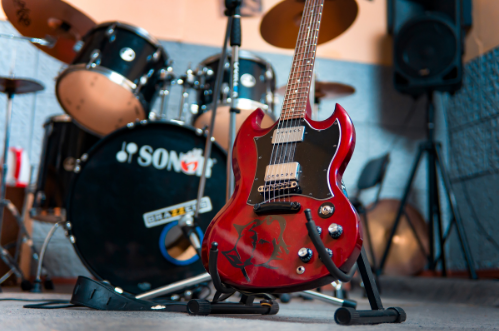
Dark shirts with dangerous-looking, bloody faces on it, black dyed hair and a slightly annoyed facial expression. Is that how you imagine a ‘metalhead’, a person listening to metal music? Whether you do or not, metal is usually not the first thing coming to mind when thinking about well-being or happiness. But bear with me, maybe you’ll be surprised.
Dark shirts with dangerous-looking, bloody faces on it, black dyed hair and a slightly annoyed facial expression. Is that how you imagine a ‘metalhead’, a person listening to metal music? Whether you do or not, metal is usually not the first thing coming to mind when thinking about well-being or happiness. But bear with me, maybe you’ll be surprised.

In the 1980s, Iron Maiden, Judas Priest, Saxon and many others shaped a generation of bands that wanted to stand out from the punk bands that dominated at the time. Combining features of punk and hard rock, they created the independent genre that was soon called ‘Heavy metal’. This genre soon became popular among fans of Hard Rock and Punk equally, especially amongst teenagers (Philips & Cogan, 2009).
With the rise of the genre and the popularity of more ‘hard’ music styles in general, a wave of concerns and hate came with it. Books and the media of that time liked to warn of the fatal consequences of rock, hard rock and heavy metal, for instance, the author Ulrich Bäumer who wrote the book We Only Want Your Soul. In his book, he did not make a distinction between genres or styles and deemed that everything with a distorted guitar and a dark image as ‘evil’, writing that ‘those groups automatically open themselves up to satanic powers and run the risk that the original ‘fun’ will be combined with diabolical seriousness’. Such statements about metal were common until the mid1990s and even today some people still believe that listening to metal or being a metalhead produces hatred towards others and violence. For the ones who share this opinion – which is an interesting take – there seems to be a clear cause-and-effect relationship. But couldn’t it also be the other way around? Instead of Metal causing hatred and violence, couldn’t it be that metal exists because there is hatred and violence, perhaps functioning as a form of protection and resilience training?
“Being involved in the music did not only allow these individuals to embody metal identities which helped them to keep away bullies as well as made them feel part of a protective community.”
A study from the University of South Australia (Rowe & Guerin, 2018) found that the ‘metal identities’ of the participants helped them handle the stress of challenging environments. They also seem to build strong and sustained identities and communities and thereby alleviate potential mental health issues. Being involved in the music did not only allow these individuals to embody metal identities which helped them to keep away bullies as well as made them feel part of a protective community. They also particularly enjoyed the music and lyrics when feeling angry or distressed, helping them to work through these feelings. This makes total sense when thinking about it: No one wants to hear a song about how great the world is when everything around you is seemingly falling apart. You want to complain for a while and scream out about how terrible the world can be! Following this thought, for many people, optimism all day every day is hard to bear. Especially when everything seems to be going wrong in their own lives. This ‘around-the-clock optimism’ often clashes with our ambivalent reality – but metal doesn’t. Metal’s dark themes possibly function as a relief and discharge, with no pressure to be in a good mood. I suppose you could say that metal counteracts the pressure to always see the world in a positive and optimistic light – and helps to reduce the negative energies by acknowledging the listener’s anger and sadness for a while.
It is legitimate to ask now, whether listening to angry, ‘extreme’ music doesn’t just intensify and strengthen the negative feelings one has when listening. A study from the University of Queensland (Sharman & Dingle, 2015) examined the relation between extreme metal music and anger processing and found quite the opposite. In the study, music listeners were subjected to an anger induction, a stress interview by Lobbestael et al. (2008) in which participants had to describe one or more events that produced a strong feeling of anger over a period of 16 minutes. This was followed by a random assignment to either 10 minutes of listening to extreme music from their own playlists, or spending the same time in silence, which functioned as the control group. The emotions of participants were assessed throughout the session by measuring their heart rate, as well as their ratings on the Positive and Negative Affect Scale (PANAS). The results of the measurements indicated that extreme music did not make angry participants angrier but rather matched their physiological arousal and even resulted in an increase in positive emotions. Instead of intensifying the negative emotion, listening to metal when angry seems to be a healthy way of processing this anger. Particularly psychology students might be irritated now, as the finding could be interpreted as evidence in favor of the catharsis theory, according to which acting aggressively or viewing aggression is an effective way to reduce angry feelings and aggressive impulses. However, quite some research in the field of psychology seems to argue against the catharsis theory, such as the conceptual analysis by Gentile (2013). These conflicting views demonstrate that more research might be necessary in order to provide deeper insights into the validity of the catharsis theory.
“While the metal enthusiasts often seemed to have some risky ‘sex, drugs, and rock-n-roll’ experiences, their ‘metalhead identity’ also served as a protective factor against negative outcomes in their lives.”
To find out what effects listening to metal – especially in one’s youth – may have in the long run, one could investigate people who were ‘metalheads’ when they were young, and compare them with the ones who weren’t. Since research in the 1980s suggested that young ‘metalheads’ were at risk for poor developmental outcomes (King, 1988), a research team in 2015 recruited many 1980s heavy metal groupies, musicians, and fans, who are now in their late adulthood, to assess childhood experiences, personality, adult attachment, and past and current functioning. While the metal enthusiasts often seemed to have some risky ‘sex, drugs, and rock-n-roll’ experiences, their ‘metalhead identity’ also served as a protective factor against negative outcomes in their lives. Additionally, they were significantly happier in their youth compared to people who did not embody a mental identity in their youth. Currently, they as well seemed to be better adjusted than other middle-aged comparison groups (Howe et al., 2015).
According to the aforementioned studies, it seems that listening a lot to metal does not, in fact, ‘steal your soul’, but may function as an outlet for negative emotions and a tool for processing anger. It can serve as a ‘protection’ against negative events, and you may even end up better adjusted in life than you would have otherwise. Recently, a paper was published that talked about ‘Heavy Metal Therapy’, comprising different aspects of the recovery movement, voice dialogue and narrative practice (Quinn, 2019). No results have been published yet but until they are, I recommend listening to some metal when feeling stressed out because of studying or feeling angry. And if you never really heard a metal song before, ‘Disturbed’, ‘Dragon Force’ and ‘Iron Maiden’ are good starting points.<<
References
-Quinn, K. (2019). Heavy metal music and managing mental health: Heavy Metal Therapy. Metal Music Studies, 5(3), 419-42
-Sharman, L., & Dingle, G. A. (2015). Extreme metal music and anger processing. Frontiers in human neuroscience, 9, 272.
-Howe T. R. et al. (2015). Three Decades Later: The Life Experiences and Mid-Life Functioning of 1980s Heavy Metal Groupies, Musicians, and Fans. Self and Identity, 14(5), 602-626, doi: 10.1080/15298868.2015.1036918
-Rowe, P., & Guerin, B. (2018). Contextualizing the mental health of metal youth: A community for social protection, identity, and musical empowerment. Journal of Community Psychology, 46(4), 429-441.
-William Phillips & Brian Cogan (2009). Encyclopedia of heavy metal music. 3-8
-Ulrich Bäumer (1984). Wir Wollen Nur Deine Seele. Rockszene Und Okkultismus: Daten, Fakten, Hintergründe. Verlag der Evangelischen Gesellschaft.
-Gentile, D. A. (2013). Catharsis and media violence: A conceptual analysis. Societies, 3(4), 491-510.
-King, P. (1988). Heavy metal music and drug abuse in adolescents. Postgraduate Medicine, 83, 295–304.
-https://www.statista.com/statistics/260819/number-of-monthly-active-whatsapp-users/.
In the 1980s, Iron Maiden, Judas Priest, Saxon and many others shaped a generation of bands that wanted to stand out from the punk bands that dominated at the time. Combining features of punk and hard rock, they created the independent genre that was soon called ‘Heavy metal’. This genre soon became popular among fans of Hard Rock and Punk equally, especially amongst teenagers (Philips & Cogan, 2009).
With the rise of the genre and the popularity of more ‘hard’ music styles in general, a wave of concerns and hate came with it. Books and the media of that time liked to warn of the fatal consequences of rock, hard rock and heavy metal, for instance, the author Ulrich Bäumer who wrote the book We Only Want Your Soul. In his book, he did not make a distinction between genres or styles and deemed that everything with a distorted guitar and a dark image as ‘evil’, writing that ‘those groups automatically open themselves up to satanic powers and run the risk that the original ‘fun’ will be combined with diabolical seriousness’. Such statements about metal were common until the mid1990s and even today some people still believe that listening to metal or being a metalhead produces hatred towards others and violence. For the ones who share this opinion – which is an interesting take – there seems to be a clear cause-and-effect relationship. But couldn’t it also be the other way around? Instead of Metal causing hatred and violence, couldn’t it be that metal exists because there is hatred and violence, perhaps functioning as a form of protection and resilience training?
“Being involved in the music did not only allow these individuals to embody metal identities which helped them to keep away bullies as well as made them feel part of a protective community.”
A study from the University of South Australia (Rowe & Guerin, 2018) found that the ‘metal identities’ of the participants helped them handle the stress of challenging environments. They also seem to build strong and sustained identities and communities and thereby alleviate potential mental health issues. Being involved in the music did not only allow these individuals to embody metal identities which helped them to keep away bullies as well as made them feel part of a protective community. They also particularly enjoyed the music and lyrics when feeling angry or distressed, helping them to work through these feelings. This makes total sense when thinking about it: No one wants to hear a song about how great the world is when everything around you is seemingly falling apart. You want to complain for a while and scream out about how terrible the world can be! Following this thought, for many people, optimism all day every day is hard to bear. Especially when everything seems to be going wrong in their own lives. This ‘around-the-clock optimism’ often clashes with our ambivalent reality – but metal doesn’t. Metal’s dark themes possibly function as a relief and discharge, with no pressure to be in a good mood. I suppose you could say that metal counteracts the pressure to always see the world in a positive and optimistic light – and helps to reduce the negative energies by acknowledging the listener’s anger and sadness for a while.
It is legitimate to ask now, whether listening to angry, ‘extreme’ music doesn’t just intensify and strengthen the negative feelings one has when listening. A study from the University of Queensland (Sharman & Dingle, 2015) examined the relation between extreme metal music and anger processing and found quite the opposite. In the study, music listeners were subjected to an anger induction, a stress interview by Lobbestael et al. (2008) in which participants had to describe one or more events that produced a strong feeling of anger over a period of 16 minutes. This was followed by a random assignment to either 10 minutes of listening to extreme music from their own playlists, or spending the same time in silence, which functioned as the control group. The emotions of participants were assessed throughout the session by measuring their heart rate, as well as their ratings on the Positive and Negative Affect Scale (PANAS). The results of the measurements indicated that extreme music did not make angry participants angrier but rather matched their physiological arousal and even resulted in an increase in positive emotions. Instead of intensifying the negative emotion, listening to metal when angry seems to be a healthy way of processing this anger. Particularly psychology students might be irritated now, as the finding could be interpreted as evidence in favor of the catharsis theory, according to which acting aggressively or viewing aggression is an effective way to reduce angry feelings and aggressive impulses. However, quite some research in the field of psychology seems to argue against the catharsis theory, such as the conceptual analysis by Gentile (2013). These conflicting views demonstrate that more research might be necessary in order to provide deeper insights into the validity of the catharsis theory.
“While the metal enthusiasts often seemed to have some risky ‘sex, drugs, and rock-n-roll’ experiences, their ‘metalhead identity’ also served as a protective factor against negative outcomes in their lives.”
To find out what effects listening to metal – especially in one’s youth – may have in the long run, one could investigate people who were ‘metalheads’ when they were young, and compare them with the ones who weren’t. Since research in the 1980s suggested that young ‘metalheads’ were at risk for poor developmental outcomes (King, 1988), a research team in 2015 recruited many 1980s heavy metal groupies, musicians, and fans, who are now in their late adulthood, to assess childhood experiences, personality, adult attachment, and past and current functioning. While the metal enthusiasts often seemed to have some risky ‘sex, drugs, and rock-n-roll’ experiences, their ‘metalhead identity’ also served as a protective factor against negative outcomes in their lives. Additionally, they were significantly happier in their youth compared to people who did not embody a mental identity in their youth. Currently, they as well seemed to be better adjusted than other middle-aged comparison groups (Howe et al., 2015).
According to the aforementioned studies, it seems that listening a lot to metal does not, in fact, ‘steal your soul’, but may function as an outlet for negative emotions and a tool for processing anger. It can serve as a ‘protection’ against negative events, and you may even end up better adjusted in life than you would have otherwise. Recently, a paper was published that talked about ‘Heavy Metal Therapy’, comprising different aspects of the recovery movement, voice dialogue and narrative practice (Quinn, 2019). No results have been published yet but until they are, I recommend listening to some metal when feeling stressed out because of studying or feeling angry. And if you never really heard a metal song before, ‘Disturbed’, ‘Dragon Force’ and ‘Iron Maiden’ are good starting points. <<



